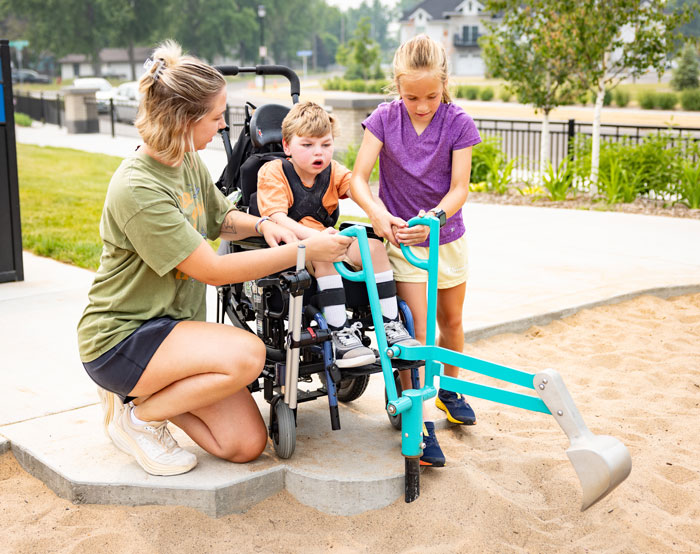A greater understanding of the multiple positive outcomes resulting from play and from interaction among children and adults with different physical and cognitive abilities has inspired playground designers to find new and creative strategies for bringing inclusivity to the playspace.
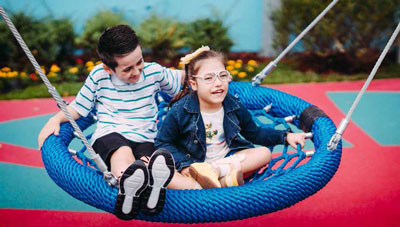
Inclusive playgrounds have come a long way since the passage of the Americans with Disabilities Act (ADA) in 1990. “Before that, in the 1970s,” said Kent Callison, director of marketing for a Fort Payne, Ala.-based manufacturer of playground and park equipment, “we introduced some freestanding accessible play products. In the 1980s we added ramps to play structures. Because there was inevitably a child in a community that used a wheelchair or mobility devices, we put ramps in our play structures.”
For years, he said, that was the main design feature for accessibility: Make sure the playground had ramps.
“After the ADA in 1990, designers and manufacturers looked at the research and saw the need on a base level to make playgrounds accessible and inclusive,” Callison added.
It’s an evolving trend that continues today.
“I think the big change to design is thinking beyond accessibility and being truly inclusive,” Callison said. “One area that is needed more than anything else is thinking not only of children with disabilities, but also adults, and making sure that the spaces you create are welcoming and inviting for people of all ages and all abilities.
“I was at a park in Wisconsin,” he continued, “and there were parents using a wheelchair. Their biggest frustration was not being
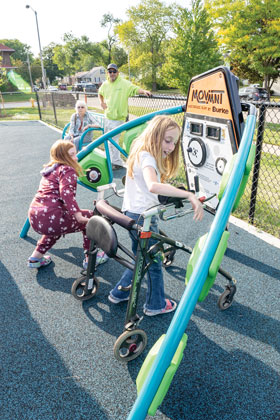
able to easily get to their child. Always remember that it is not just the person playing that needs an inclusive environment, but also their caregivers.”
What’s driving exponential growth in inclusive play, and new approaches to designing inclusive playgrounds, suggested Anne-Marie Spencer, corporate vice president of marketing for a Chattanooga, Tenn.-based company that designs and manufactures play and park equipment, is a growing awareness “of the fact that active, independent play is essential to the health and well-being of every individual, regardless of age or ability.”
Designing a truly inclusive environment involves understanding the many ways that people may experience play, and creating opportunities that foster encouragement and success for every ability. The developmental benefits of play are not limited solely to children, but are important throughout life.
“As awareness grows around the fact that opportunities for play and recreation are often limited for people with disabilities—who are the most vulnerable members of a community—the interest in inclusivity-designed play and recreation environments, programs and services has also grown,” Spencer said. “They serve as excellent catalysts for creating welcoming atmospheres, fostering a profound sense of belonging, creating awareness and promoting positive community outcomes.”
The importance of play and of all people seeking and preferring different ways to play are drivers in the growth of inclusive play, said Sarah Lisiecki, communications and education manager for a Fond Du Lac, Wis.-based playground manufacturer. “Inclusive design is simply good design,” she said. “From our perspective, research has been a game-changer in inclusive play design. Elevating the voices of people who are sometimes unheard is the best way to make sure the space will really be one of joy, growth and inclusion for all. It’s taking the approach of listening, then doing and not being afraid to be different and create designs that are unique and new.”
Inclusive Playground Essentials
For many years, the focus for accessible spaces was on access for those with limited mobility. However, inclusive play is not just
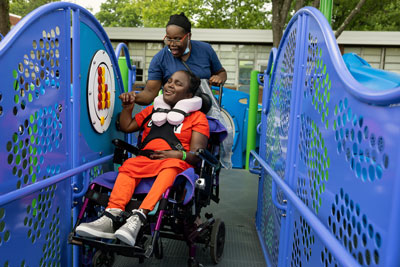
about physically accessing an environment, but should be equally focused on the experiences once an individual gets there, Spencer said. “A great inclusive space not only breaks down barriers to physical access but also intentionally breaks down barriers for individuals of all abilities to socially participate.”
Providing communities with inclusive destinations and opportunities to develop the skills to independently play and recreate together can be profound. “Inclusive spaces should feel and be welcoming, active, supportive, equitable and diverse, creating more usable experiences for more people to the greatest extent possible,” Spencer said.
As for essentials, creating genuinely inclusive and welcoming play experiences should start with intentional design focusing on the developmental needs of the whole child. Research continues to demonstrate the importance of play across the interconnected domains of child development: physical, social-emotional, sensory, cognitive and communication.
“Children, and all individuals of all abilities, need to be able to be active, exercise self-determination, engage in social interactions, learn and understand,” Spencer said. “This can result in higher self-esteem, positive self-identity and well-being, which have a lasting effect on an individual throughout their adult life. Designing a play area to encourage these experiences takes more than meeting access guidelines or counting ground level vs. elevated experiences. It takes working with someone who understands the research and can put research into practice.”
Agreeing with Spencer is Jill Moore, inclusive play specialist with a Delano, Minn.-based play equipment manufacturer. Designing a truly inclusive environment involves understanding the many ways that people may experience play, and creating opportunities that foster encouragement and success for every ability, Moore said.
“A big part of that is understanding who you are designing for. It’s something communities can do that is a cool aspect of
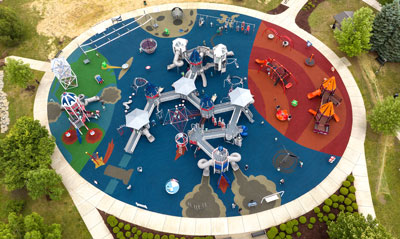
designing. Is there a park in this area that more people with physical disabilities are going to use, or do I have an area near a high school so I might also be thinking about kids with learning disabilities?”
Every inclusive playground is unique, Moore said. “You want to have a lot of diversity for your sensory systems. With disabilities, a user might need more practice to build a particular skill. We want things that are going to be at different challenge levels, and also things that bring kids together. That is a staple of inclusive play. I want more activities in a playground that are going to encourage kids with different abilities to encounter something together.”
Meeting ADA requirements is merely the baseline of accessibility. It’s essential, but isn’t the full scope, Lisiecki said. Focusing on Universal Design means the spaces are designed for everyone—spaces that resonate with everyone. This means there is a variety of play activities that can relate to either a child’s or adult’s interest. No matter the individual’s ability or attention level, there is something that meets them where they are and challenges them to grow.
Bringing Inclusivity to Existing Spaces
Retrofitting an older, existing playground to make it more inclusive can be a daunting endeavor. “There is often pressure coming from every angle now because the idea of inclusive playgrounds is going viral, and there are families all across your communities saying, ‘We need something inclusive,’” Moore said. “That’s awesome, but oftentimes you find that park and rec entities might struggle with this because it is a more expensive solution, such as having to buy new surfacing, more accessible components.”
The advice Moore suggests? “Look, people might feel they have to do it all in one bite, whereas you can spread it out. If you
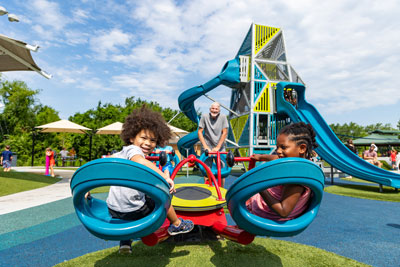
have a playground and want to make it more inclusive, you can retrofit. You can add an inclusive piece to it over time. Do things in phases, one component at a time, where it doesn’t have to be this big, giant, expensive overhaul.
“As a park and rec executive, look at your older parks, one that needs a lot of maintenance and is not ADA-compliant. Try to get some funding, a grant or state money. Focus on the one that needs the most change,” Moore said.
From there, consider the surrounding community to determine what is most needed. “Is there a physical occupational therapy treatment center nearby? If so, you might need sensory components,” Moore said. “Or maybe you need to design for kids with autism by including retreat spaces.
“With autism in mind, design with different challenge levels, design with panels to help with communication if you have a person who is nonverbal. Look at what is around in the park, and that could help when you are wondering what has to change, how you need to change, how to prioritize funding and how can this be done on a sustainable level.”
More advice comes from Spencer, who said that depending on the age and configuration of the space, a playground may be retrofitted, new amenities added or an expansion designed.
“In some cases,” Spencer said, “even if the equipment is welcoming to people of all abilities, a break in the overall design can create unnecessary boundaries due to misplaced parking, excessively long or complex travel routes, a lack of maintenance or consideration for surfacing, or other considerations. It’s best to speak to a playground designer trained in basic principles of inclusive playground design or another inclusion expert, who can evaluate the whole space and make recommendations.”
Adding new play events to existing playgrounds is a great way to refresh these spaces and generate renewed excitement and
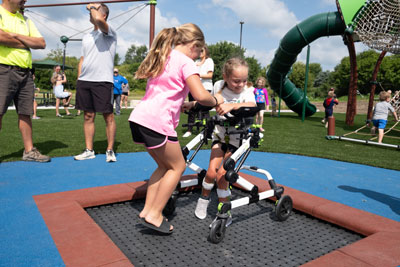
interest. Just make them more inclusive, said Lisiecki.
Include some intergenerational pieces that inspire people of all ages and abilities to move and exercise. “That is a wonderful way to add inclusion, keep communities healthier and bring more interest to the space. Outdoor electronic play can be this type of play event,” Spencer said.
Considerations When Starting New
When your goal is to create a new inclusive playspace from the ground up, you should begin by documenting how opportunities to participate in inclusive, equitable play experiences throughout one’s life is a right that enhances the quality of life for children, families and our greater society, Spencer advised.
“Talk to the community,” she said. “Sometimes it’s hard to understand who makes up the community just by looking at who may be using existing amenities. If the space isn’t built to encourage and support inclusive play and recreation, there is very little reason for people with diverse needs to go there. Hold community outreach meetings to understand the desires and needs of community members.”
Take steps to understand how disabilities are represented in your community demographic. Seek out what recreation opportunities, if any, are currently available and how they are meeting the diverse needs of all people.
“Consider interviewing people of all abilities at this stage to understand how and if they are engaging with existing services and to get feedback on what an inclusive play and recreation environment could mean to the community,” Spencer said. “Meaningful outreach and education are required to involve the right people in planning and execution; creativity and innovation are required to ensure the space is universally designed and developmentally appropriate to the greatest extent possible; and most importantly, expertise is required to ensure that the direction, design and execution result in the desired outcomes. Ask suppliers for examples of inclusive spaces they’ve designed and built, and ask them to explain why they chose those projects to share. Ask about their research or data that can support their position.”
Lisiecki offered a series of key elements to consider before the ground is broken on a new inclusive playground. They include:
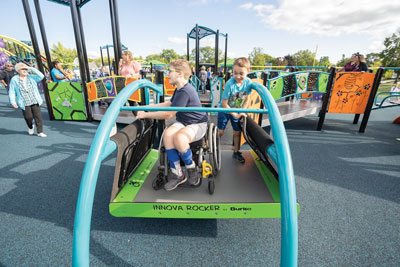
- Age range: What ages of children or adults will be using this space?
- Inclusivity: Creating a space that is both accessible and equitable means everyone will be able to find the best of themselves through play.
- Universal Design: Applying the principles of Universal Design is important to make certain everyone is able to not only access but fully engage in play.
- Capacity: How many people will be playing at once?
- Budget: How much can we spend?
- Space: How much room do we have to create this space, and how can we best use it to meet our objectives?
- Play experience: Adventure? Theme? Fitness? A combination of all of these? What type of play experiences do we want users to have?
- Location: Is our location easy to access? How can we make sure everyone can easily be part of the environment? Is this location adjacent to another play or recreation space?
- Parking: Where will people park? How many people will park here at the same time?
- Signage: Signage can convey important information including rules and equipment use. Making certain everyone can understand this information is crucial. It’s also important that everyone feels welcome. If someone can’t understand what is being conveyed, they may not feel the space was designed for them and will not feel as welcome to use it.
- Surfacing: What type of surfacing meets the needs of users?
- Visibility: How will people know about this park? Can they see it from the street? A neighborhood? Signs?
Now Do More
As progressive as inclusion is getting, said Moore, “I still meet communities who tell me they don’t have anybody with special
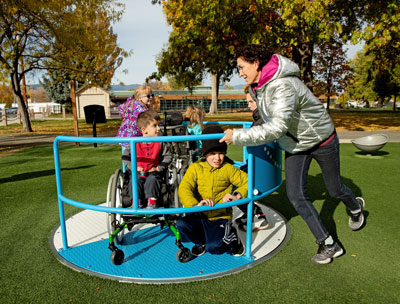
needs in their community. For somebody to say that, I still have people come back to me saying they don’t have spaces for somebody with a disability to go. As much as inclusion is growing, it is important that people recognize that every community has people with disabilities, and all of those people have a lot of vitality. They add a ton to the equation.”
Awareness is a big part of this. Recognize that people with disabilities want to engage in activities like everybody else. “I get excited when people say they want an inclusive playground, an inclusive space, and ask me what they need to know, what does that need to look like?,” Moore said. “Curiosity is a cool thing that we are seeing more of. I want people to be curious. I want people to ask, ‘How can this happen? How can we do that?’”
One way is by gaining more understanding of what disability looks like. “A big point is that right now within the disability community there is a movement called ‘nothing about us without us.’ That is to say, we cannot design for the disabled population without including them in the process. It is most important to broaden our understanding,” Moore said.
“Differences in ability are a natural part of the human experience that in no way diminishes an individual’s right to fully participate, including the fundamental right to play throughout our lives,” Spencer said. “What is not a natural part of the human experience are the barriers we create in built environments, such as parks and playgrounds.”
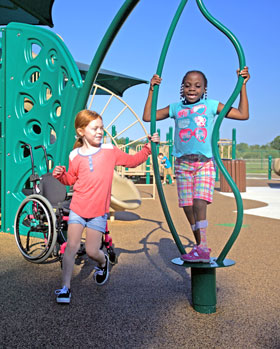
“Part of designing the built environment is establishing the environmental demands or requirements for who can participate in the activities that take place there,” Spencer said. When people create places to play and recreate, they also decide, through that process, what individuals must be able to do in order to use the environment. “Whenever the requirements or unnecessary demands of the environment are greater than the abilities of the user, a disability is created,” Spencer noted.
This is an important shift in perspective, she said. Many individuals with disabilities reside within the built environment of communities, but due to the misalignment of the requirements to use the environment, they may often still not be or feel included in that community.
A great idea to heighten awareness is to consult with children with disabilities and their families during the design process, said Jolie Ross, marketing director for a Greenville, S.C.-based manufacturer of playground equipment. “There’s a lot to be done but most importantly, providing equitable access to inclusive spaces for all communities, including those in underserved areas, rural regions and low-income neighborhoods, where access to inclusive play spaces may be limited.” RM



